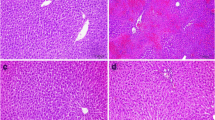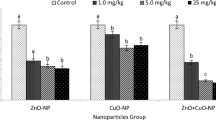Abstract
The present study was planned to determine the potential of zinc in attenuating the toxicity induced by 131I in rat blood. Female wistar rats were segregated into four main groups. Animals in Group I served as normal controls; Group II animals were administered a dose of 3.7 Mbq of 131I (carrier free) intraperitoneally, Group III was supplemented with Zinc in the form of ZnSo4.7H2O (227 mg/l drinking water), and Group IV was given a combined treatment of Zinc as well as 131I, in a similar way as was given to Groups IV and II animals, respectively. The effects of different treatments were studied on various parameters in rat blood including hemoglobin (Hb) levels, % hematocrit, zinc protoporphyrins (ZPP), activities of enzymes which included aminolevulinic acid dehydratase (δ-ALAD) and Na+ K+ ATPase and uptake of 65Zn in blood. The study revealed an increase in the levels of hemoglobin, % hematocrit, activities of δ-ALAD, Na+ K+ ATPase and uptake of 65Zn, 7 days after the 131I treatment. On the contrary, the levels of ZPP were found to be significantly decreased after 131I treatment. However, zinc treatment to 131I-treated animals significantly attenuated the various biochemical and hematological indices. Moreover, zinc treatment to the 131I-treated animals could significantly decrease the uptake of 65Zn, which was increased after 131I treatment. Based upon these data, the present study suggests that zinc has the potential to attenuate 131I induced toxicity by restoring the altered hematological indices and biochemical changes.
Similar content being viewed by others
References
Franklyn JA (1994) The management of hyperthyroidism. N Engl J Med 330:1731–1738
Franklyn JA, Daykin J (1991) Long term follow up of treatment of thyrotoxicosis by three different methods. Clin Endocrinol (Oxf) 34:71–76
Doniac I (1956) Comparison of carcinogenic effects of x-irradiation with radioactive iodine on the rat’s thyroid. Br J Cancer 11:67–76
Blomfield GW, Eckert H, Fisher M, Miller H, Munro DS, Wilson GM (1959) Treatment of thyrotoxicosis with I131, a review of 500 cases. Br Med J 1:63–79
Walinder G, Sajoden AM (1972) Late effects of irradiation on thyroid gland in mice. Comparison between irradiation of fetuses and adult. Acta Rad Ther Phy Biol 111:201–208
Triggs SM, Williams ED (1977) Experimental carcinogenesis in the rat thyroid follicular and C cell; a comparison of the effect of variation in dietary calcium ad of radiation. Acta Endocrinol 85:72–78
Thurston V, Williams ED (1982) The effect of radiation on the thyroid c-cells. Acta Endocrinol 99:72–78
Kasuba V (1997) Biological effects of the Iodine 131 radionuclide. Arh Hig Rada Toksikol 48(2):247–257
Grunwald F, Schomburg A, Menzel C, Steinecker S, Spath G, Bockisch A (1994) Changes in the blood picture after radioiodine therapy of thyroid cancer. Med Klin 89(19):522–528
Konukoglu D, Husrev Hatemi, H, Arikan S, Demir M, Ackey T (1998) Radioiodine treatment and oxidative stress in thyroidectomised patients for differentiated thyroid cancers. Pharmacol Res 38:311–315
Palecz D, Leyco W (1983) Effect of gamma radiation on enzymatic activity and sulphydryl groups of human erythrocyte membrane. Int J Radiat Biol Relat Stud Phys Chem Med 44(3):293–299
Bartoc R, Dumeitrescu C, Belgun M, Olienscu R (1993) Oxidative and antioxidative factors in the serum of thyroid cancer patients treated with I-131. Rom J Endocrinol 31(1–2):85–87
Dani V, Dhawan DK (2005) Radioprotective role of zinc following single dose radioiodine-131 exposure to red blood cells of rats. Indian J Med Res 122:338–342
Prasad AS (ed) (1983) Clinical, biochemical and nutritional spectrum of zinc deficiency in human subjects: an update. Nutr Rev 41:197–208
McCall KA, Huang C, Fierke CA (2000) Function and mechanism of zinc metalloenzymes. J Nutr 130:1437S–1446S
Coyle P, Philcox JC, Carey LC, Rofe AM (2002) Metallothionein: the multipurpose protein. Cell Mol Life Sci 59:627–647
Floersheim GL, Floersheim P (1986) Protection against ionizing radiation and synergism with thiols by zinc aspartate. Br J Radiol 59:597–602
Matsubara K (1986) Protective effect of zinc against lethality in irradiated mice. Environ Res 41:558–567
Floersheim GL, Chiodelti N, Bieri A (1988) Differential radioprotection of bone marrow and tumour cells by zinc aspartate. Br J Radiol 61:501–508
Cagen SZ, Klassen CD (1979) Protection of carbon tetrachloride induced hepatotoxicity by Zinc: role of metallothionein. Toxicol Appl Pharmacol 51:107–116
Chvapil M, Ryan JN, Zukoski CF (1972) Effect of zinc on lipid peroxidation in liver microsomes and mitochondria. Proc Soc Exp Biol Med 140:642–646
Sidhu P, Garg ML, Dhawan DK (eds) (2004) Protective role of zinc in nickel induced hepatotoxicity in rats. Chem-Biol Interact 150:199–209
Dhawan DK, Goel A (1994) Protective role of zinc on rat liver function in long- term toxicity induced by carbon tetrachloride. J Trace Elem Exp Med 7:1–9
Dacie JV, Lewis SM (1984) Practical haematology, 6th edn. Churchill Livingstone, New York
Burch HB, Siegel AL (eds) (1971) Improved method for measurement of delta-aminolevulinic acid dehydratase activity of human erythrocytes. Clin Chem 17:1038–1041
Wallech DFH, Kamat VB (1966) Separation of plasma membrane fragments from mouse ascites tumor cells. Methods Enzymol 3:16–21
Fiske CH, Subbarow Y (1925) Colorimetric determination of phosphorus. J Biol Chem 66:375–378
Lowry OH, Rorebrough NJ, Farr AL, Randall J (1951) Protein measurement with the folin phenol reagent. J Biol Chem 93:265–275
Akram H, Mahboob T (2004) Red cell Na K ATPase activity and electrolyte homeostasis in Thalassemia. J Med Sci 4:19–23
Sato M, Nagai Y (1989) Effect of zinc deficiency on the accumulation of metallothionein and cadmium in the rat liver and kidney. Arch Environ Contam Toxicol 18:587–593
Liu XY, Jin TY, Nordberg GF, Rannar S, Sjostrom M, Zhou Y (1992) A multivariate study of protective effects of Zn and Cu against nephrotoxicity induced by cadmium metallothionein in rats. Toxicol Appl Pharmacol 114:239–245
Durnan DM, Palmiter RD (1981) Transcriptional regulation of mouse metallothionein 1 gene by heavy metals. J Biol Chem 256:5712–5716
Walden TL, Draganac PS, Farkas WR (1984) The elevation of blood levels of zinc protoporphyrin in mice following whole body irradiation. Blood 63:1159–1167
Haeger-Aronsen B, Schutz A (1978) Anatagonistic effect in vivo of zinc on inhibition of delta-aminolevulinic acid dehydratase by lead. Arch Environ Health 31(4):215–220
Simons TJ (1995) The affinity of human erythrocyte porphobilinogen synthase for Zn2 and Pb2. Eur J Biochem 234:178–183
Gibbs PNB, Gore MG, Jordan PM (eds) (1985) Investigation of the effect of metal ions on the reactivity of thiol groups in humans: aminolevulinate dehydratase. Biochem J 225:573–580
Goel A, Dani V, Dhawan DK (2005) Protective potential of Zinc on lipid peroxidation, antioxidant enzymes and hepatic histoarchitecture in chlorpyrifos induced toxicity. Chem-Biol Interact 156:131–140
Bandhu HK, Dani V, Garg ML, Dhawan DK (2006) Hepatoprotective role of zinc in lead treated protein deficient rats. Drug Chem Toxicol 1:11–24
Dhawan DK, Sen T, Dani V (2006) Effectiveness of Zinc in modulating the CCl4 induced oxidative stress in rat liver. Toxicol Mech Methods 16:37–40
Lowe NM, Bremnr I, Jackson MJ (1991) Plasma 65Zn kinetics in the rat. Brit J Nutr 64:445–451
Sidhu P, Garg ML, Dhawan DK (2004) Biokinetics of 65Zn in liver and whole body and its biodistribution in nickel treated protein deficient rats. Indian J Exp Biol 42:969–975
Author information
Authors and Affiliations
Corresponding author
Rights and permissions
About this article
Cite this article
Dani, V., Malhotra, A. & Dhawan, D. 131I Induced Hematological Alterations in Rat Blood: Protection by Zinc. Biol Trace Elem Res 120, 219–226 (2007). https://doi.org/10.1007/s12011-007-8027-1
Received:
Revised:
Accepted:
Published:
Issue Date:
DOI: https://doi.org/10.1007/s12011-007-8027-1




